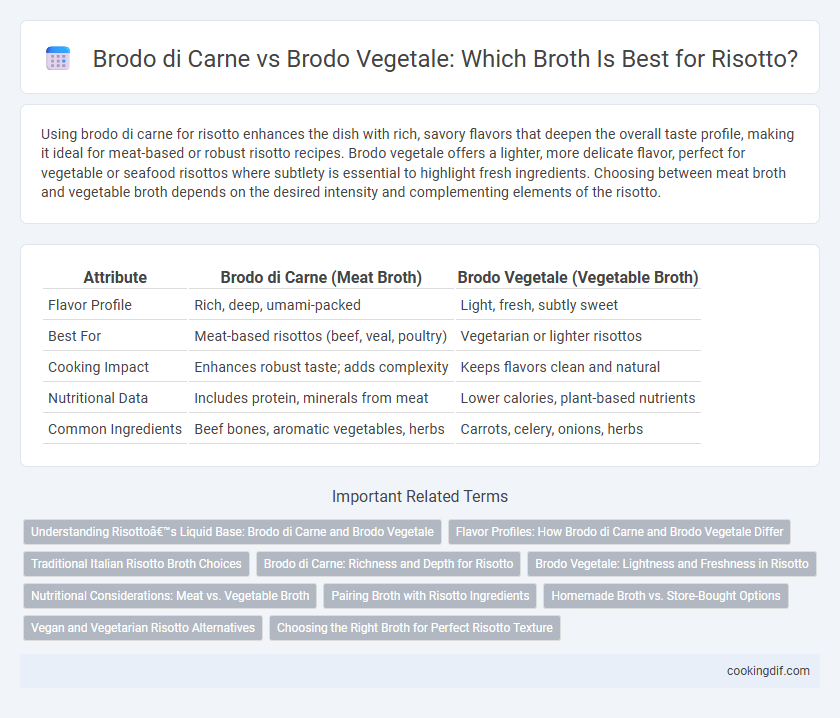Using brodo di carne for risotto enhances the dish with rich, savory flavors that deepen the overall taste profile, making it ideal for meat-based or robust risotto recipes. Brodo vegetale offers a lighter, more delicate flavor, perfect for vegetable or seafood risottos where subtlety is essential to highlight fresh ingredients. Choosing between meat broth and vegetable broth depends on the desired intensity and complementing elements of the risotto.
Table of Comparison
| Attribute | Brodo di Carne (Meat Broth) | Brodo Vegetale (Vegetable Broth) |
|---|---|---|
| Flavor Profile | Rich, deep, umami-packed | Light, fresh, subtly sweet |
| Best For | Meat-based risottos (beef, veal, poultry) | Vegetarian or lighter risottos |
| Cooking Impact | Enhances robust taste; adds complexity | Keeps flavors clean and natural |
| Nutritional Data | Includes protein, minerals from meat | Lower calories, plant-based nutrients |
| Common Ingredients | Beef bones, aromatic vegetables, herbs | Carrots, celery, onions, herbs |
Understanding Risotto’s Liquid Base: Brodo di Carne and Brodo Vegetale
Brodo di Carne, a rich meat-based broth, imparts deep umami flavors and a robust aroma, enhancing the complexity and depth of risotto dishes, particularly those featuring red meats or mushrooms. Brodo Vegetale offers a lighter, more delicate flavor profile derived from simmered vegetables, making it ideal for vegetable or seafood risottos where subtler tastes are desired. Choosing between these broths directly influences the final texture and flavor intensity, shaping the risotto's character and balancing its ingredients effectively.
Flavor Profiles: How Brodo di Carne and Brodo Vegetale Differ
Brodo di Carne imparts a rich, savory depth to risotto with its robust, meaty umami notes derived from simmered bones and meat, enhancing dishes like mushroom or beef risottos. Brodo Vegetale offers a lighter, fresher flavor profile, highlighting earthy vegetables and herbs that complement delicate risotto variations such as asparagus or spinach. Choosing between these broths significantly influences the overall taste, texture, and aroma, tailoring the risotto experience to either hearty or subtle palates.
Traditional Italian Risotto Broth Choices
Brodo di Carne, made from simmered beef or chicken bones, imparts a rich, savory depth that enhances the umami profile of traditional Italian risotto, making it ideal for meat-based varieties like Risotto alla Milanese. Brodo Vegetale, crafted from simmered vegetables such as carrots, celery, and onion, offers a lighter, more delicate flavor that preserves the subtlety of vegetable or seafood risottos while maintaining the classic creamy texture. The choice between these broths significantly influences the final taste and authenticity, with brodo di carne providing robustness and brodo vegetale delivering a clean, fresh finish.
Brodo di Carne: Richness and Depth for Risotto
Brodo di carne enhances risotto with a robust, savory richness that elevates the dish's depth and complexity. Made from simmered beef or veal bones, this broth imparts intense umami flavors, creating a hearty foundation that complements the creamy texture of Arborio rice. The collagen extracted during slow cooking also adds a velvety mouthfeel, intensifying the overall sensory experience of traditional risotto.
Brodo Vegetale: Lightness and Freshness in Risotto
Brodo Vegetale imparts a lightness and fresh aroma to risotto, allowing the natural flavors of the rice and other ingredients to shine without overpowering them. Its vegetable-based composition enhances the dish's delicate texture and provides a clean, vibrant taste profile ideal for spring or summer risottos. Using Brodo Vegetale as the liquid base maintains a subtle balance that complements ingredients such as asparagus, peas, and herbs, delivering a refreshing and nuanced flavor experience.
Nutritional Considerations: Meat vs. Vegetable Broth
Meat broth used in risotto provides higher protein content and richer amino acids, enhancing umami flavors and supporting muscle maintenance. Vegetable broth offers lower calories and fat, with antioxidants and vitamins that promote overall health and lighter digestion. Choosing between brodo di carne and brodo vegetale impacts not only taste but also nutritional profiles, catering to dietary preferences and health goals.
Pairing Broth with Risotto Ingredients
Brodo di carne enhances risotto dishes with rich, robust flavors ideal for mushroom, beef, or game-based risottos, complementing their earthy and savory profiles. Brodo vegetale offers a lighter, more subtle taste that pairs well with vegetable risottos featuring asparagus, zucchini, or peas, preserving their fresh and delicate notes. Selecting the appropriate broth based on risotto ingredients intensifies the overall flavor harmony and depth of the final dish.
Homemade Broth vs. Store-Bought Options
Homemade Brodo di Carne provides a rich, savory depth to risotto, enhancing the dish with natural umami and gelatin that store-bought broths often lack. Brodo Vegetale offers a lighter, vegetarian-friendly flavor profile, using fresh vegetables to complement delicate risotto recipes without overpowering ingredients. Choosing homemade broth ensures control over seasoning and freshness, resulting in a more authentic and aromatic risotto compared to commercially processed alternatives.
Vegan and Vegetarian Risotto Alternatives
Brodo Vegetale, a vegetable broth, offers a rich, plant-based liquid ideal for vegan and vegetarian risotto, enhancing flavors without animal products. Brodo di Carne, or meat broth, imparts a deeper, umami flavor traditionally favored in classic risotto recipes but is unsuitable for vegan or vegetarian diets. Opting for brodo vegetale ensures a flavorful, cruelty-free risotto while allowing for versatile ingredient pairings such as mushrooms, saffron, or seasonal vegetables.
Choosing the Right Broth for Perfect Risotto Texture
Brodo di carne, rich in umami and gelatin, imparts a deep, savory flavor and creamy texture perfect for hearty risottos, while brodo vegetale offers a lighter, subtle taste ideal for delicate vegetable or seafood risottos. Selecting the right broth influences the risotto's mouthfeel and enhances the specific flavors of the main ingredients, ensuring a balanced and harmonious dish. Quality homemade broths made from fresh bones or garden vegetables provide the best base for achieving the desired risotto consistency and richness.
Brodo di Carne vs Brodo Vegetale for Risotto Liquid Infographic

 cookingdif.com
cookingdif.com